Nathaniel Benjamin has now spent most of his life in Reno, Nevada, where he co-founded Laika Press with some friends from UNR’s printmaking department. In the one year that I’ve lived here, I’ve seen his work in public, printed on shirts and beer cans, or in the gallery. I hadn’t had the chance to talk with him until recently when we had a conversation surrounding his Holland Project Window Gallery exhibition Terms and Conditions.
Using his artist statement as a jumping point, I asked Nathaniel how he saw the relationship between humans and technology; both positive and negative. We continued to explore the many ways technology has changed the way we interact with one another, its role in our current “era of misinformation”, as well as the relationship between printmaking and digital mass media.
* This interview was transcribed from a video interview and has been slightly edited for clarity.
Nathaniel: I’ve been doing research listening to podcasts on how to have a conversation about art today, so I feel ok.
Otis: What podcast are you listening to?
N: A podcast that’s now called Hello, Print Friend. I’ve been trying to do more research on what other printmakers are doing. I went to the printmaking conference a long time ago, this one that happens every year, and I kind of got turned off to the whole world of it because they were all about paper and carving tools and chemicals, and it was cool, but it was more about the science.
O: Not so much about the content but the practice.
N: Totally. And there were good conversations you could have with people but it wasn’t what was immediately encouraged I guess. I just want to be aware of what other people are doing.
O: Well that was one of my questions, what kind of artists are you looking at right now?
N: I’ve been looking more at printmakers, there are a lot of printmakers that I do really respect, who are more not on the academic side of things I feel like. Because even as I listen to this podcast I’m learning that almost all the people she’s talking to and about are professors, or are involved in academia in some way, and I think that has a lot to do with access to printmaking presses in general. I’m learning a lot today, this is just what’s fresh on my mind. Most of the artists I look at are street artists or other muralists, more community-based artists. In the other podcast I listened to today, she interviewed Killjoy, who is this Philipina printmaker and street artist who I found through this other guy. They both live in Mexico City and he goes by Grafica Mazatl. His style is similar to mine and I’m always looking for artists who are obviously making work in a similar way because I want to push my game you know? And be more attentive to little details that I’m not noticing. There is also Aaron Horkey, he’s from Minnesota and did a lot of album artwork for local bands I was listening to. And his work is so technically refined, his subject matter is all over the place and I don’t know, he’s just brilliant.
O: And what music are you listening to now?
N: It depends on what I’m doing I guess, most played genres on my Spotify are probably vaporwave, then black metal. I listen to vaporwave because it’s very easy to listen to and it’s one of those things that fills the space in your mind while you’re doing something else, and black metal is more when I’m actively doing something.
O: I understand and totally agree. What shirt are you wearing?
N: This is Tribulation.
O: Sweet, haven’t heard of them. I’m less into black metal, I’m getting more into thrash metal. I keep asking my friend what kind of metal I like because I never really know, I just like speed and aggression. My favorite band right now is Gulch.
N: Nice, I’ll check them out.
O: Your artist statement says you grew up religious in the Midwest, could you tell me where exactly and what religion?
N: Yea, so when I say I grew up in the Midwest, I was there for middle school and high school, otherwise, we moved all over the place. Thinking about it now, I’ve lived in Reno longer than I’ve lived in the Midwest at this point. But I was mostly in Omaha, Nebraska, then Sioux Falls, South Dakota, then a couple of small towns nearby. Honestly, I’m not that grounded in any specific location, just the US in general. Because we did move around a lot including Pennsylvania, Tennessee, Arizona, Colorado, a ton of different places I’ve lived but the Midwest were formative I think.
And I was raised Christian in general, in Sioux Falls it became more specific to Presbyterianism which is like, more legalistic I would say. I don’t really know how this plays into what I do as much, but what I carried away from that are the memories of being in church really bored and reading Revelations just to pass the time. It’s very mystical writing going over a bunch of imaginative monsters and ceremonies and rituals. This was being infused to me every week because I was bored and there’s always a bible in the pew in front of you. That apocalyptic narrative and the mystical side of Christianity I found really interesting and I think it helped form what I do now and how I think about things.
O: I was interested because most of my education was through a religious school in St Louis. I always liked how the Bible was used to teach us good, but was equally still full of chaos.
N: Absolutely.
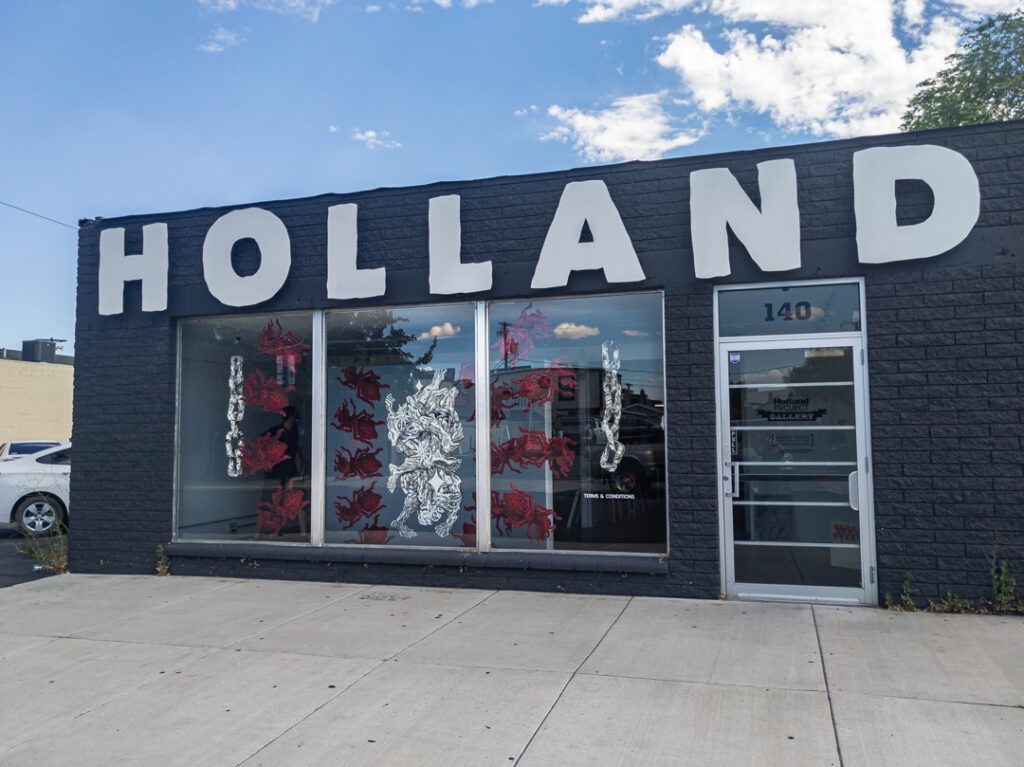
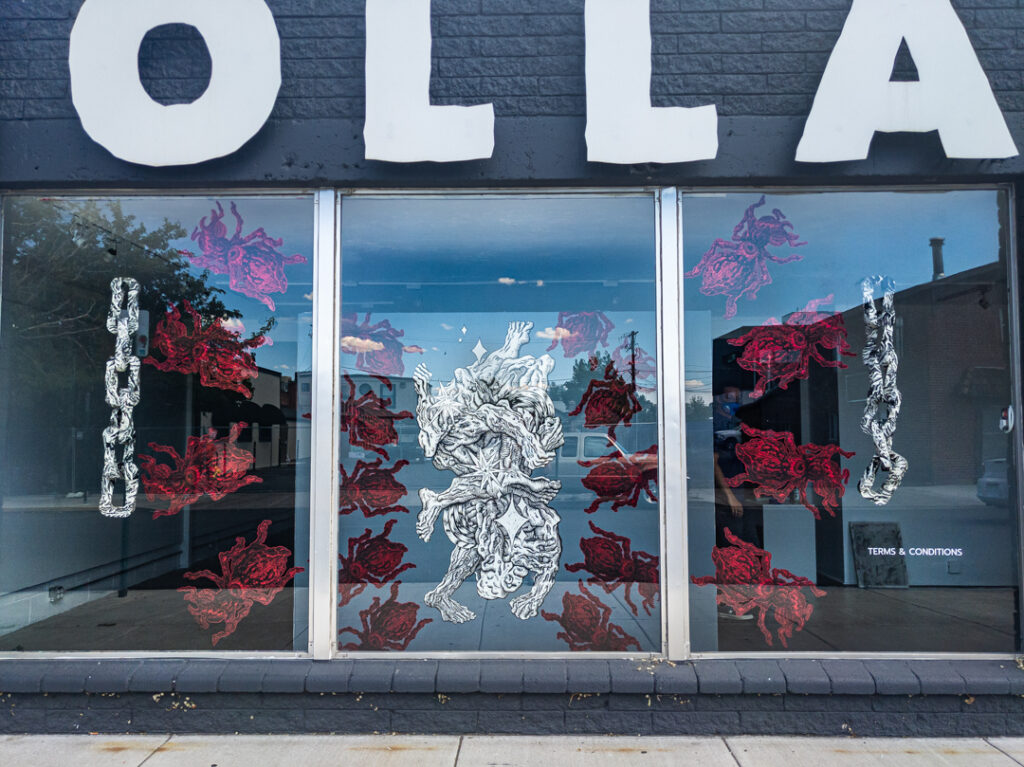
O: This is more of an obvious question that has to do with your artist statement, but how do you see technology and digital media getting in the way of human connection? Also, how have you seen ways in which technology has helped connect us to one another? Because when I read your statement it doesn’t seem to paint technology in the best light. When of course many others might see technology as an important tool for connection. Facetiming a relative who lives far away for example.
N: Totally. I mean, especially in COVID that’s totally a thing. We were cut off physically but through our phones and everything we could still be in touch with people. I mean, I struggle with my artist statement too, it’s been a while since I wrote one, and I always rehash the same stuff and figure out how it carries over to this new work. And I think I’ve completely figured out how to speak about it honestly because there is a desire to ground the work in words and language, but it’s not just that, there’s a lot more to it and I don’t want to feel like I’m caging it into one thing. I think a lot about how technology cuts us off from one another, but it’s definitely not the only thing that it does, it’s more complex than that. So I’m not all that into the artist statement that I wrote. But to answer your question, some ways that it gets in between people – this conversation we’re having for example is substantially different from if we were face to face. Right now there are cars driving by me, my context is completely different than yours. Even eye contact; I don’t know how to do that over the phone because do I look at the camera or do I look at your face? Being in a physical space with one another is a different connection where you’re connected emotionally and experiencing things at the same time, in the same moment, in a much different way than a screen is able to present information or regurgitate it back.
O: Sure
N: And I’m not necessarily saying it’s all bad, it’s easy to say that it’s all bad though. It’s hard to explain how it’s nuanced in a small artist statement though you know? Even the way I’m listening to this podcast this morning learning more about what I do, and the other communities that exist that are doing similar things, I’ve learned so much today and can connect with these people, 2 of which I already follow on Instagram, just to be able to watch and see what they do because I was interested in how they talk about what they do. None of that could have happened otherwise without technology. So it creates the possibility for different connections. And it’s very tempting for me to say that it’s degrading all of how society works on a large scale, because of the outcomes especially that we’ve seen in the past year that wouldn’t have happened otherwise… Like you would think through a pandemic, if we can’t find common ground in a global pandemic, that’s fucked. That’s the one opportunity where people should have been like “Ok we are in this together”, but then we all started to form these little tribes that are diametrically opposed, and we gravitate towards those things in opposition to other things instead of saying that this is an actual thing and we should put our differences aside because we are all depending on one another to make this whole thing work. But people ended up denying the reality of a deadly virus that’s killing people and people are still convinced by that, and it’s like that specific circumstance would never have happened 10 years ago, maybe in smaller amounts but it would never have gained the global attention like it has today.
O: I was thinking about how information can be passed along through social media on a global scale, connecting us from around the world and being able to see the other side of things. But this kind of connection is completely different than smaller, more personal relationships. I think we often use the excuse that technology is so unifying, but personally I’ve found it to be distracting and detrimental to my real, personal relationships.
N: Yea, I’m learning more about how tech companies approach how they make their devices and apps. How, through using Ai and algorithms, and removing the human element from the process that chooses how and why we see what we see, we lose control over what we’re looking at, and it feeds into our actual neurons and gives the reward chemicals for doing things that contribute to sales basically. The more things sell, the more successful it is and that means more ads to make more money. It utilizes human weaknesses. It’s the same with gambling. They have the same mechanisms built into our phones, and it’s by design. They chose those things because they have worked for years and years, tested by gambling companies.
So there’s a better way of doing things, where it’s not just feeding into Capitalism in the end with all these things that are detrimental to living our lives in healthy ways. But that’s just not how our phones are operating right now. And I’m wondering if I should even explain this in my artist statement because this is the background of why I do this, but it’s not what I want people to take away from my work necessarily, I want people to take away what they want from it, because it is an artwork and that’s the whole point right?
But this work represents how we are all entangled together, and we’re fighting. This is one weird amalgamation of limbs, but that’s what we are all doing and what we are driven to through these interactions we have on our phones. It doesn’t have to be that way, and we could exist in a much more healthy relationship with these things, but it comes down to how those companies are driven, and they are driven by money, and that just accentuates the wealth gap and all these other problems that no one wants to exist.
And I don’t know, I feel like most of my conversations fall apart when I get to this point because now we are talking about this thing that none of us have individual control over. And I want technology to be awesome! It really is mindblowing the things being made these days, and it could be really great, but it’s just so scary to see where we are at right now, and what it is being used for. And none of us have control over this.
O: What a feeling of helplessness. This image of human limbs wrestling with each other also made me think about how social media makes me feel so competitive. I may feel like I’m connected to other artists, or that I’m a part of something bigger but I always end up feeling deficient in some way probably because I compare myself to others.
So are they ants or termites?
N: They were originally meant to be ants, but they can be termites if you’re more comfortable with that.
O: I was really just trying to make a connection between the title and the insects.
N: Oh yeah! Terms and Conditions is just something I was thinking about, because we all get notified by these million-page contracts that say who knows what, we say yes, and then that’s it. We are on this thing, which is then going to in the long run shape our behavior whether we know it or not. So that’s the step you take from personal accountability into collective accountability I guess, and you become disconnected from yourself in this weird way. Because you’re then playing into whatever it is, and you don’t even know what it is!
O: Right, so I’m thinking about legally binding contracts now... And the terms and conditions are essentially what you are giving up to have access to something else right? So for example, I can have access to a certain app, so long as they have the authority to send me notifications… That would probably be a term/condition that would actually have an impact on how much I’m looking at my phone, knowingly or not.
N: Right. And I mean, again the connection between the information and content that I’m drawing off of vs the work that I’m making, I don’t think that they are like this (*links fingers together*), I end up going down this rabbit hole of defending myself in my artist statements for doing that for some reason, but what I do intentionally vs what ends up happening in the work are very different I think, and I think over time if I’m consistently trying to talk about this thing it will become more clear, but I’m definitely in the middle of that process you know?
But I‘m happy with the way things turned out so I’m wondering if I’m even committed to making work like this, because it took about a year and a half and I enjoyed the process of making it, but learning about all this stuff was really depressing. And that could also have been COVID lockdown, it was just a weird weird time but I was asking myself if I wanted to make work like this because it’s not really doing anything to help the situation, coming up with solutions is probably better…
O: Well, I also don’t think it’s necessarily about taking a stance right? I feel like it’s perfectly fine to make work just based on your observation of how things are.
N: I just have this mixed relationship with how I talk about my art because it wasn’t easy for me to learn how at UNR (University of Nevada, Reno). And this was my second go at college after a 5-year break, but I struggled with adapting to that specific mindset they were trying to teach. And I think it’s an artist thing in general that it’s just hard to talk about your work. I don’t know, I’m tempted to intellectualize it, and make it about something, but in the end, well even in the beginning I guess, I was like, I don’t know what the fuck I want to make work about right now because everything is going to hell, so I’m gonna make a big block that looks like some gross skin! Like that was the whole idea! And that evolved into something, but it was about me shutting off and saying just do it and I’ll figure it out as I go, and not trying to analyze it at all until afterward.
O: I think that’s healthy.
N: Yeah! I think it’s better that way. But the process got very mixed up because of COVID, and I didn’t go through the normal progression that I would have, and it got really messy in my head. It was a weird show to make for a weird time. I’m sure everybody who you talked to who has made work during COVID was probably in a similar place.
O: Yeah. I mean, it’s hard to focus on just one issue now I feel like. That’s what artists like to do right? Focus on issues and wish they could come up with solutions? That’s why I think it’s important to act on your instincts and then worry about why you did it later.
N: Right. And it’s like two different parts of your brain, you can’t really figure out what it is because it’s changing as you’re making it, you know?
O: Yeah.
N: Yeah.
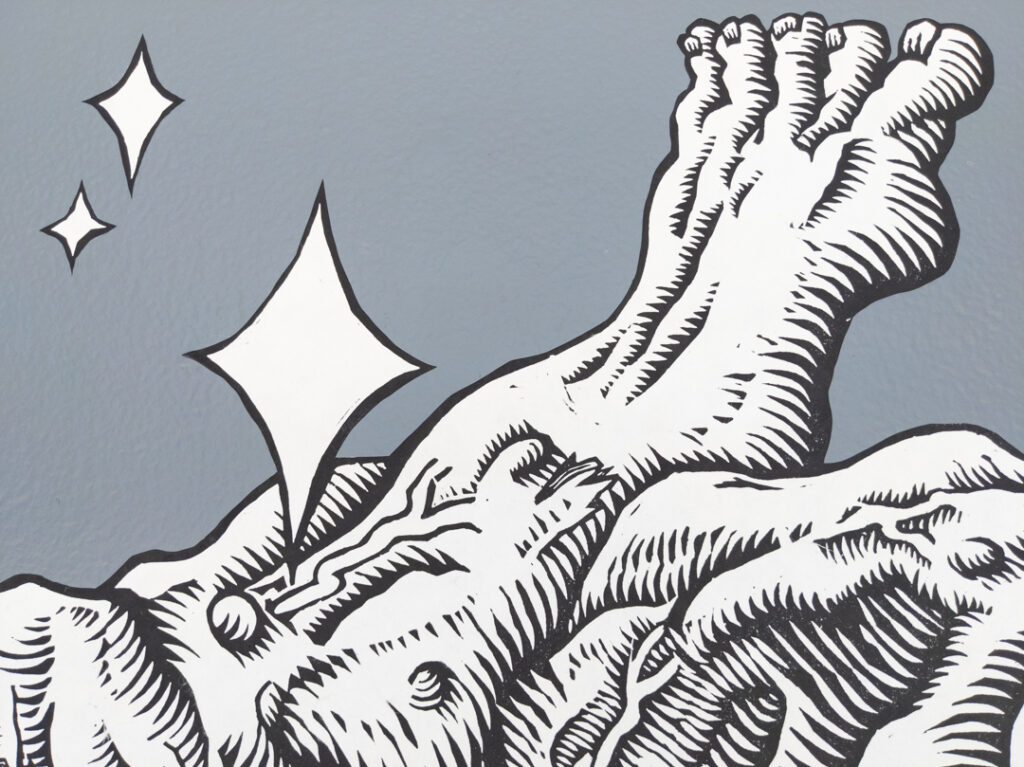
O: How big was this piece of wood you carved? One single piece?
N: Yeah, 6’ by 4’ maybe, I wanted to do something that was more human size.
O: So a door.
N: Yeah. So in my midway and thesis exhibitions at UNR I tried to do more largescale printmaking work, so for my midway show, I did a whole bunch of prints on mylar. They were transparencies that layered on top of each other like old-school anatomy books. I did this goopy-looking guy like eight feet tall, and it had a footprint probably like six by six feet, and that was a lot of fun. So I wanted to keep doing large-scale work in general. And I had so much fun with murals because you were using your whole body to do this thing. So I’m trying to bridge that gap in print work where I can make prints and then wheat paste them wherever I travel to or whatever. Doing large-scale work is just a lot of fun. One of the main things I enjoy about making prints is that it’s very much a time investment where you sit with this thing you already drew, and you’re just putting in the work and time to turn it into a block that you can print off of. And there’s still some creative liberty while you’re doing that, and I don’t overly draw what the lines are going to look like, I try to use the tool to kind of figure that out as I go. But it’s a big-time investment, this was a year and a half. Maybe between 50 and 80 hours. And that was just to carve the one block. Then making a print on it takes like two hours. And it’s cool because I know I can make as many prints as I want from this and put them up wherever I want.
O: But you also have to store that block…
N: Yeah. Fortunately, there’s storage space at Laika Press. Very fortunate to print there. Because I started carving in my garage, I was carving it in the backyard sometimes, but it’s a big thing to lug around.
O: Do you want to talk a little bit about Laika Press? You co-founded it correct?
N: I’d love to, yeah it was me and a group of friends who all met in the printmaking department at UNR. And our teacher suggested a few times to start a press, because once you graduate you don’t have access to a lot of equipment like I was saying. But yeah Holland helped us find a space, and we got a couple of presses mostly donated, we had a heads up on a surplus sale too. So now we have all the stuff you need to make prints, and then you can just come in and use the space and equipment to make your project. We have capabilities for screen printing, the press to do woodcuts, linocuts, both relief printing techniques. Stuff to do etching, copper plates, monotype, cyanotype, collagraph.
O: I went to Prague as a student in 2016, and we worked with Pavel Pikar who was an exhibiting printmaker. He taught us how to print with linoleum but that’s the only printmaking I’ve ever gotten to do.
N: Oh sweet, I think linocut is what I’ve done most honestly. Same technique I used for this work, just with wood. And the reason I used wood for this exhibition is that they’re bigger pieces. You could get an eight-by-four piece of wood for like $20. But I don’t even think they make linoleum that big.
O: Cuts like butter though.
N: Right, the battleship-grade linoleum is my favorite thing to cut. It’s so good.
O: And I think you already answered this, but I wanted to know if you had any comments to make on this current “era of miscommunication”? And the role that technology has to play in that.
N: Yeah I mean it’s nuts. I’ve been watching the HBO QAnon documentary…
O: I’ve seen it all.
N: It’s SO nuts. That’s what I was watching when I was making part of this work. I have one episode left. These people who don’t know anything about what they’re doing… And I don’t want to be too insulting because they’re just people who ended up with so much power just by the sake of circumstance. And those are the people who are now influencing the decisions and beliefs of millions of people all of a sudden. It doesn’t make sense. And it’s driven by this culture of like, a lack of trust in institutions, which I can sympathize with. We often don’t know what’s going on, but there are different directions you can take from there. It feels like a global trip, where we’re all on acid at the same time and everyone’s like, “This is reality!”, but it’s not grounded in anything. The internet became such an integral part of our lives so quickly, it’s like it bypassed all these gateways of natural selection. And it’s really scary that this all happened within one generation, because if things are moving at this speed, then there’s no predicting what’s going to happen next. I don’t know if that exactly answers your question, but misinformation just creates all of these potential worlds, when we technically exist in the same one. But now it’s full of a million tiny bubbles, and we get to choose which one we feel safe in. And we are content believing that that’s the whole world when it’s not. It’s disconnecting us from each other so much that it’s becoming dangerous.
O: This is reminding me more about the insects in your work, and I’m thinking about the notion of the “hivemind”. I know it’s not a very positive term, but don’t you kind of wish we could all get on the same page about something, or have a goal to work together towards?
N: The way the insects are arranged they kind of reminded me of a mandala, but ants are just a ubiquitous thing that exists and that operate under the radar, but they also all have eyeballs and they are all bleeding. It was kind of a spontaneous image I made and I still haven’t thought too much about what it means. In the past, I’ve used flies to represent things, and I’ve picked up on different meanings that other people have suggested for it, but in the end, bugs are what eats us once we’re dead, and they’re going to continue after we are gone most likely. They are very insignificant to us, but much more significant in the long run. And the eyeballs kind of make me think of surveillance, but we all have different perspectives too so all this adds up into some weird thing that we are all participating in but that we can’t come to an agreement on. It was easy for me to say this is what this middle piece means, but the other stuff I don’t really know. It just made sense.
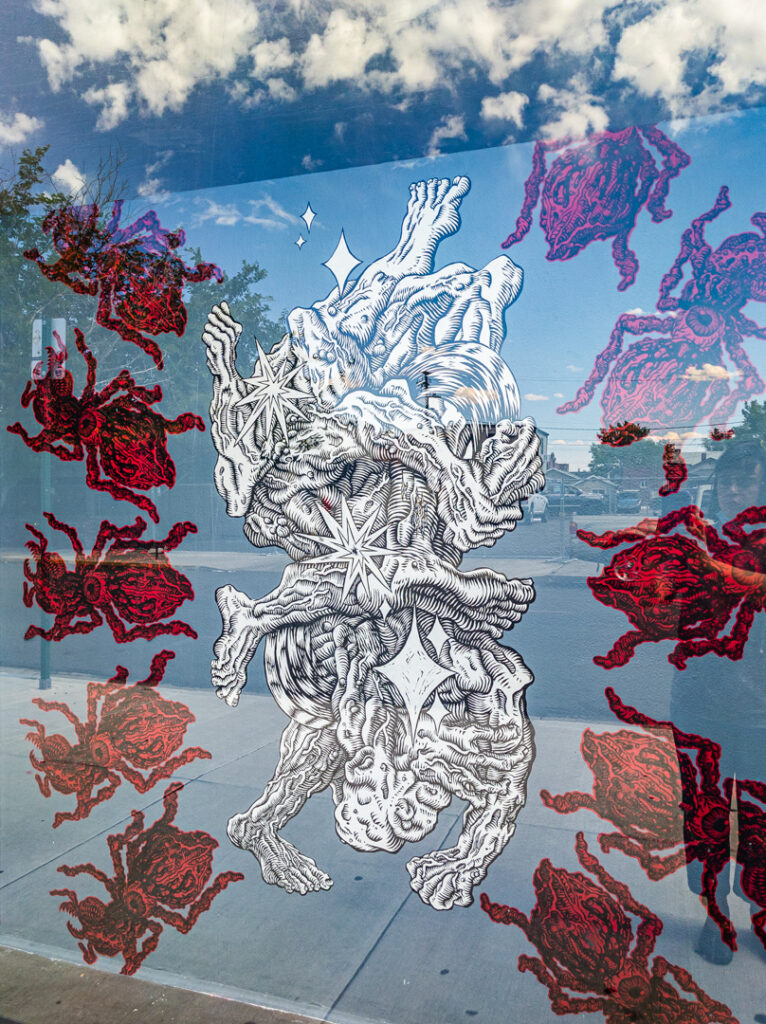
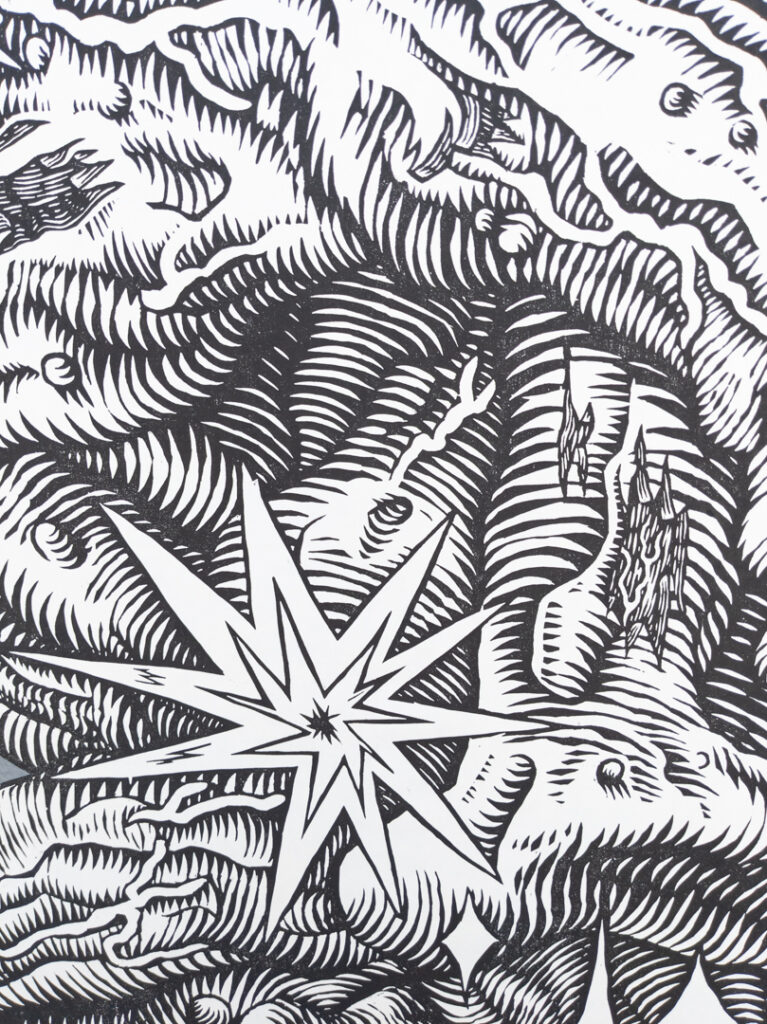
O: Well the other body of work that I really enjoyed was from 2017 you titled Infinite Surface. It was all colorless, with lots of digital iconographies and it’s overall just very hardcore. Your statement for that collection of work was very similar to this, and you touched on the superficialness of digital interfaces when we aren’t there to interact with them, and the sort of symbiotic relationship we have with technology. I just thought that that body of work really represents your artistic process super well.
N: Thank you for saying that, that’s good feedback. Yeah, most of those etchings I didn’t even like in the end, it was just confusing for me, but to hear you say that it’s really affirming honestly.
O: Right on, I’m glad I could do that. What kind of etching were they?
N: Copperplate.
O: That’s an older form of printmaking right?
N: Yeah, I think it took off during the Renaissance.
O: Like around Francisco Goya?
N: I think he was later, but yeah he did the Disasters of War I think it’s called. I saw those recently in Chicago. I was blown away.
O: I’d love to try copper etching myself. In your statement, you said you also noticed a relationship between your printmaking practice and the content you’re dealing with. It made me think of Art in the Age of Mechanical Reproduction by Walter Benjamin and the history of reproduced images. I also noticed you used repetition as a composition tactic in this installation.
N: Yeah, so when you make a print, you allow it to exist in multiple different contexts, and detached from its own. And I feel like that’s directly evolved into what we do on our phones all the time. But it’s hard for me to understand how to best harness that connection I guess. It’s still a physical object, so it’s unique in that way. But how does that connect to my content, and are those things working together to express that message and point out that difference in quality I guess. I guess that’s kind of the problem I’m facing in making my work. How do I get it all to work in the same direction? But I want to enjoy what I’m doing also. I’m always fighting myself thinking it should be doing something more than it is, but I want to enjoy it.
O: A lot of asking yourself why right? Why the hell?
N: Totally
O: You have any more cool projects coming up?
N: Next up I kind of want to do more of this, large blocks, but I want to manage my time better. It usually ends up falling on the back burner, because I need to make money and this doesn’t make money. So I’m going to try to be more intentional about dedicating more time to work on stuff like this. I did most of my carving about two weeks before this was ready to show, and my arm was ready to fall off. I feel like I caused some possibly permanent damage to my body, it was pretty bad. So I want to keep working at a larger scale, but at a more sustainable pace. And I want to bridge the gap between my public art and my printmaking work. That’s definitely a solid goal of mine, even though I don’t know exactly what it will look like.
O: Thanks so much Nathaniel, I’m really happy to get to know you and your work a little better.
N: For sure, I appreciate you giving me the chance to talk about this. It’s only in these kinds of contexts that I ever talk to anyone about my work, so.
O: I think it’s also how people like to hear about artwork too, straight from the artist.
N: Yeah, and it involves having a longer conversation. Because I don’t like receptions. If I have a reception for my work I’m somewhere but you’ll have to look for me, and if I do have a conversation about this work with you, it’s not going to mean much you know? And I love talking to people about my artwork, it’s just not always easy to do. So yeah I appreciate the opportunity to have this kind of interview.
You can read and see more at nathanielbenjamin.com
